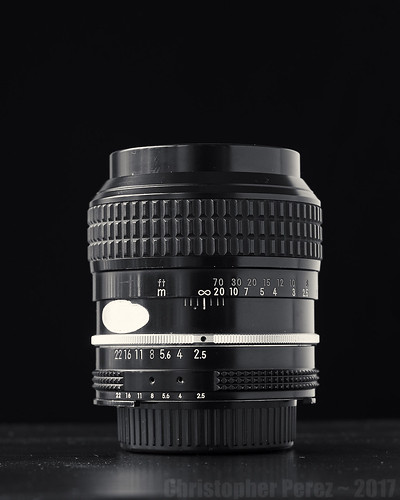
I mentioned that I once had too many 85mm Nikon Nikkor manual focus lenses. To solve the problem I put two up for sale. Instead of selling the 85mm f/1.8 H I traded it for a Nikon Nikkor 105mm f/2.5 AiS.
Over the years I've tended to prefer 85mm over 100mm lenses. The 85mm focal length felt somehow "natural" to me, where the 100mm lenses I owned never did. The 100mm lenses felt too "tight" on a subject and didn't feel like it had much "depth".
It's only 20mm longer than an 85mm, but that small difference in focal length made this a challenging lens for me to use. I constantly needed to take a few steps more steps away from my subject and, of course, I found myself in spaces with little room to move. In the cases where there was enough room to step away from the subject the perspective was slightly, but visibly flattened.
So why this 105mm Nikkor in my Box of Toys? With too many 85mm lenses and after having already sunk the original investment costs I thought it could be interesting to add another focal length to the kit for no monetary outlay. It would give me the opportunity to see once and for all if there was any magic in this lens, to see if there was that special "something" that I'd missed over all the years of using lenses and cameras.
In the history of 35mm lenses the 105mm f/2.5 Nikkor is legendary. Steve McCurry used this kind of lens to make his famous image of the Afghan Girl. Some folks on the internet consider the 105mm to be one of the best portrait lens ever made. There seems to be a lot to recommend it.
In practice the lens is slightly sharper wide open than any of the 85mm Nikkors I've owned. Stopped down, of course, there is no difference in resolution between most lenses as the sensor is the limiting factor until you reach the limits of optical diffraction around f/11 or f/16 (depending on sensor site size). The field is flat and unlike the 85mm K Nikkor there are no Petzval-inspired "swirls" in the out of focus regions.
The lens might have felt critically sharp, clinically modern except for one thing. The no-Petzval-inspired out of focus regions are incredibly smooth and creamy. It looks like something from another age by the way it balances nice resolution against the way the sharpness falls off. Perhaps the effect is a result of the simple four element three group design?
Modern computer generated optical designs are commonly much more complex than the 105mm Nikkor. For example, Sigma's new 85mm f/1.4 Art implements fourteen elements in twelve groups. While the Sigma is no doubt outstanding in nearly every measurable way, I'm finding I prefer the "look" of old simple classic optics.
I used to think the best out of focus rendering lens in my current collection of optical tools was the 85mm f/1.8 K. Reconsidered, I find I'm wrong. Of all the lenses I currently have and all the 35mm lenses I have ever owned this 105mm Nikkor f/2.5 AiS has the best out of focus rendition. It's simply marvelous.
[example1, example2]
No comments:
Post a Comment